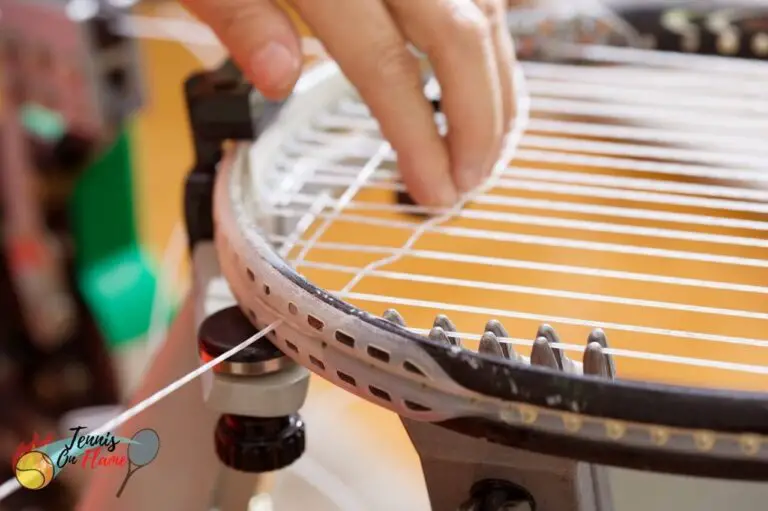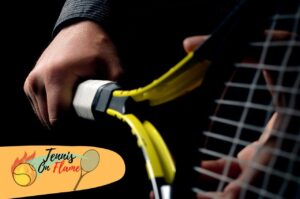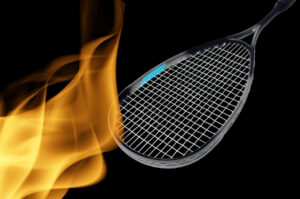How to choose tennis strings for your racket? Well, there are many factors to consider when choosing the right tennis strings for your game.
The type of string, the gauge, and the tension can all affect how the ball moves and how you play.
In this comprehensive guide, we will discuss each of these factors in detail and help you choose the best strings for your game.
Whether you are a beginner or an experienced player, this guide will help you find the perfect strings for your needs!
How to pick and choose tennis strings?
Tennis strings are made from materials such as polyester, nylon, and synthetic gut.
These different types of tennis strings have different properties that affect how the ball travels and bounces off them.
The most popular type of tennis string is polyester which feels stiffer than other types but offers more spin control on serves or groundstrokes.
Nylon strings are the most popular type of string for beginners because they offer a softer feel and more durability than other types of strings.
The synthetic gut is a mix of polyester and nylon which offers a good balance between durability, control, and feel.
The gauge or thickness of the string also affects how the ball travels and how you play.
Thinner strings will generally allow more spin while thicker ones provide better control but less spin potential on shots like serves or groundstrokes.
The tension of your string also affects how much power you get off a shot, so it’s important to find the right balance between these three factors.
Most players find that a higher gauge and lower tension give them more power while a thinner string with high tension provides more spin.

The different types of tennis racket strings
Here are some of the types of tennis strings on the market today that will help you understand how to choose tennis strings:
Natural Gut
This is the most expensive type of tennis string and it is made from animal intestines.
This type of string provides the best feel, control, and durability.
However, it also has a shorter lifespan than other types of strings.
Multifilament:
These are strings that are made up of many smaller filaments.
They are often softer than other types of strings but also have less durability.
Polyester:
These strings offer great control and spin potential for players who want to put a lot of topspin on the ball.
Synthetic Gut:
This is a mix between the natural gut and multifilament, so it offers some feel with more durability than other types of strings.
It also has a lower price point than either natural gut or multifilament.
Kevlar:
These strings are made of Kevlar, a material that is commonly used in bulletproof vests.
They offer great control and durability but they have less feel than other types of string materials.
Hybrids:
These are strings that are made of two or more different materials.
They offer players the best of both worlds in terms of feel, control, spin potential, and durability.
Tennis strings by playing style
Now that you know about the different types of tennis strings, it’s important to consider how your playing style will affect which type of string is best for you.
Here are some general guidelines:
Tennis strings by power
If you’re just getting started and aren’t familiar with how to generate your power, as well as for youngsters who haven’t fully developed their muscles, then I recommend you to use natural gut or nylon strings.
Tennis strings by control
If you have a rate of your electricity and want assistance in directing the ball, polyester is the best choice for you.
Polyester strings are less elastic than natural or synthetic gut, but that means they will also give you more control over where your shot lands on the court.
Tennis strings by feel and comfort
For senior players who are more susceptible to arm injuries such as tennis elbow, or for those who have previously experienced arm problems, I recommend using comfort strings made of soft materials like natural gut or nylon.
Tennis strings by spin
If you want to give a high level of spin on your shot and create a heavy tennis ball, polyester is the best choice for you.
Polyester strings are less elastic than natural or synthetic gut, but that means they will also provide more control over where your ball lands on the court and which direction it spins in when struck at an angle by players who generate their power.
Tennis strings by durability
If you are looking for a string that can last and not break as easily, I recommend synthetic gut or Kevlar strings.
The synthetic gut is made of multiple materials which give it more durability than nylon while Kevlar is known to be one of the most durable materials available in the market.
What is the most durable string?
Kevlar strings are the most durable type of tennis racquet string available.
They offer great control and durability but they have less feel than other types of string materials.
The Tennis String Gauge
The gauge of your string affects how the ball travels through it and how much power you get off each shot.
A thinner string will generally allow more spin while thicker strings provide better control but less spin potential on shots like serves or groundstrokes.
Most players find that a higher gauge and lower tension give them more power while a thinner string with high tension provides more spin.
The Tennis String Tension
Tennis string tension is the amount of pressure you put on your strings to hold them taught.
This affects how much power you get off each shot, so it’s important to find the right balance between these two factors.
Most players find that a higher gauge and lower tension give them more power while a thinner string with high tension provides more spin.
What tennis string tension should I use?
This depends on your playing style.
However, most manufacturers recommend stringing elastic materials like nylon or natural gut at a weight of 50 to 60 lbs.
What type of strings do professional tennis players use?
The most popular strings used by professional tennis players are polyester.
This is because it offers great control and spin potential for players who want to put a lot of topspin on the ball.
However, there are many other types of strings available that can fit any player’s needs.
How often should I change my tennis strings?
This depends on how often you play, but most players will need to restring their racket as much as they play tennis during the week-
So it can take a few hours for a weekend warrior, but up to a day or two for someone who plays four or more days per week.
If you don’t play tennis very often, then it might not be worth changing your string as often because it’ll probably last longer before breaking down.
How do I choose good tennis strings?
There are many different types of strings, each with its cons.
Choose your string based on how often you play, your playing style, and the type of surface that you prefer.
What is the best string for a spin?
Natural gut or polyester strings offer the greatest potential for a spin because they provide more friction than other types of tennis racquet strings.
However, the several factors affect many spins you can generate, so it’s important to try out a few different types of strings to find the one that works best for you.
What is the most popular tennis string?
Polyester tennis strings are the most popular type of racquet string for recreational and professional players.
They offer a good balance between power, control, spin potential, and durability.
Do tennis strings make a difference?
Tennis strings make a difference in how you play the game.
They affect how much power or spin you can generate, whether your shots are accurate, and even if they last long enough before needing to be replaced (which is why choosing good quality ones can save money).
Should I choose my string based on price?
No, you should not choose your string based on price.
There are many different types of strings available and each has its benefits and drawbacks.
It’s important to find the right type of string for your playing style and preferences to get the most out of your game.
How much should I spend on tennis strings?
The price of tennis strings can vary greatly.
They range from as little as $0.50 per string to over $20 for a set of three or four reels, so it’s important to consider all factors before making your purchase decision.
What does the thickness of tennis strings mean?
The thicknesses listed on strings are in thousandths of an inch.
The higher the number, the thicker the string.
Thicker strings provide more power while thinner strings offer more spin potential.
In conclusion
Choosing a string that’s right for you is important because it affects how well your racquet performs when hitting shots.
But there are so many different types available with varying benefits and drawbacks, so it can be difficult to know which one will work best in any given situation.
I hope this article about how to choose tennis strings has helped answer some of your questions about tennis strings.
Remember, the best way to find out what works for you is to try out a few different types and see which one gives you the best results.
Happy shopping and good luck on the court!








